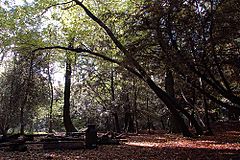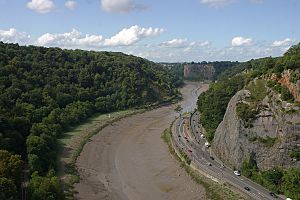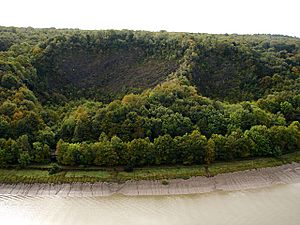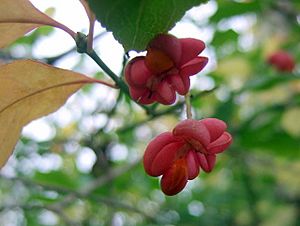Leigh Woods National Nature Reserve facts for kids
Quick facts for kids Leigh Woods |
|
|---|---|

The woods in early autumn
|
|
| Lua error in Module:Location_map at line 420: attempt to index field 'wikibase' (a nil value). | |
| Type | Open access woodland |
| Location | North Somerset, England |
| Area | 2 square kilometres (490 acres) |
| Operated by | National Trust, Forestry Commission |
| Status | Open all year |
Leigh Woods is a beautiful forest covering about 2 square kilometers (or 200 hectares). It's located on the southwest side of the Avon Gorge, very close to the famous Clifton Suspension Bridge. You can find it in North Somerset, right across the river from the city of Bristol.
This special woodland was once part of the large Ashton Court estate. Inside Leigh Woods, you'll find Stokeleigh Camp, which is an ancient hillfort. People lived there a very long time ago, from around 300 BC to 100 AD, and maybe even later in the Middle Ages. Along the River Avon, there are old quarries where people used to dig for limestone and a mineral called celestine. These quarries are not used anymore.
In 1909, a part of Leigh Woods was given to the National Trust. This was done by George Alfred Wills to stop new buildings from being built too close to the gorge. Other parts of the woods are now looked after by the Forestry Commission. Leigh Woods is home to some rare trees, including many types of Sorbus (also known as whitebeam or rowan trees). You can also see the Bristol rockcress (Arabis scabra), which only grows in the Avon Gorge, flowering in April. Different kinds of orchids and western spiked speedwell (Veronica spicata) are common in June and July. Because of its unique plants and animals, Leigh Woods is a national nature reserve and part of the Avon Gorge Site of Special Scientific Interest.
Contents
Exploring the Landscape of Leigh Woods
Leigh Woods covers an area of about 2 square kilometers. It sits on a ridge, which is like a long, narrow hill. This ridge is mostly made of limestone, with some sandstone. It stretches all the way from Clifton to Clevedon, which is about 16 kilometers away on the coast.
At the southern end of the woods, you'll find Nightingale Valley. This is a dry valley, meaning it doesn't have a river flowing through it all the time. It slopes down to the River Avon, right next to the Clifton Suspension Bridge. If you enjoy long walks, the Monarch's Way long-distance footpath goes through Leigh Woods.
A Look Back: The History of Leigh Woods
Leigh Woods has a rich history, with signs of people living and working there for thousands of years.
Stokeleigh Camp: An Ancient Hillfort
Inside Leigh Woods is Stokeleigh Camp, an ancient hillfort. It's believed that people lived here from around 300 BC to 100 AD. It might have also been used in the Middle Ages. This fort is located on a high point, covering about 7.5 acres.
Archaeologists think Stokeleigh Camp was first used by the Dobunni tribe during the Iron Age. Later, in the 1st century, there might have been Belgae tribes here. Some pottery found suggests connections to the Durotriges tribe. It's unclear if the camp was used by soldiers or as a safe place during difficult times.
Old Quarries and Unique Trees
North of Stokeleigh Camp, you can see old quarries that overlook the River Avon. These quarries are no longer used. In the late 1800s and early 1900s, one of these was an important quarry for celestine, a mineral. There was even a special tramway that carried the celestine to a dock on the river.
Today, this area has been turned into an arboretum, which is like a tree garden. At the northern end of the woods is a place called Paradise Bottom. This area was part of the Leigh Court Estate. In the 1860s, Sir William Miles planted some of the first giant redwood and Weymouth pine trees in the UK here. These were "exotic" trees brought from other countries.
The Growth of the Area
To the south of Leigh Woods is a nice neighborhood also called Leigh Woods. It grew after the Clifton Suspension Bridge opened in 1864. The bridge made it easier for people to live in Leigh Woods and travel to Bristol. Houses were built here from the mid-1860s until the First World War.
In 1909, George Alfred Wills, who owned a tobacco company, gave part of the woodland to the National Trust. He did this to protect the area from being covered by new houses as Bristol grew. Later, in 1974, the government bought more of the woodland. Today, the National Trust and the Forestry Commission work together to look after Leigh Woods.

A railway line, the Portishead Railway, runs along the bottom of the woods near the river. It opened in 1867 but closed for passengers in 1981. It was reopened for cargo trains in 2001. There are plans to bring back passenger services to Portishead in the future.
Leigh Woods is a popular spot for outdoor activities. People enjoy mountain biking on the small circuits and it's a great place for walking and rock climbing.
Nature's Wonders: Flora and Fauna
Leigh Woods is very important for its rare plants and animals. Because of this, it's part of the Avon Gorge Site of Special Scientific Interest and 140 hectares of it are a national nature reserve.
Trees and Plants
The southern part of the woods used to be pasture land with old trees that were pollarded (cut back to encourage new growth). These are mainly oak trees and some small-leaved lime trees. The northern part is ancient woodland with a wide variety of trees.
Some of the rare trees include the Bristol whitebeam (Sorbus bristoliensis) and the wild service tree (Sorbus torminalis). Leigh Woods is especially important for Sorbus trees, with at least nine native types and four types brought from other places.
On the steep, grassy slopes above the River Avon, you can see the Bristol rockcress (Arabis scabra). This plant is unique to the Avon Gorge and flowers in April. Different kinds of orchids and western spiked speedwell (Veronica spicata) are common in June and July. In autumn, the woodland is home to over 300 types of fungi! You can also find Bilberry, which is rare in the Bristol area, and the parasitic plant yellow bird's-nest (Monotropa hypopitys).
Animals and Insects
Birds that live in Leigh Woods include the raven (Corvus) and the fast-flying peregrine falcon (Falco peregrinus). In summer, many different butterflies and moths can be seen, such as the white-letter hairstreak (Satyrium w-album).




